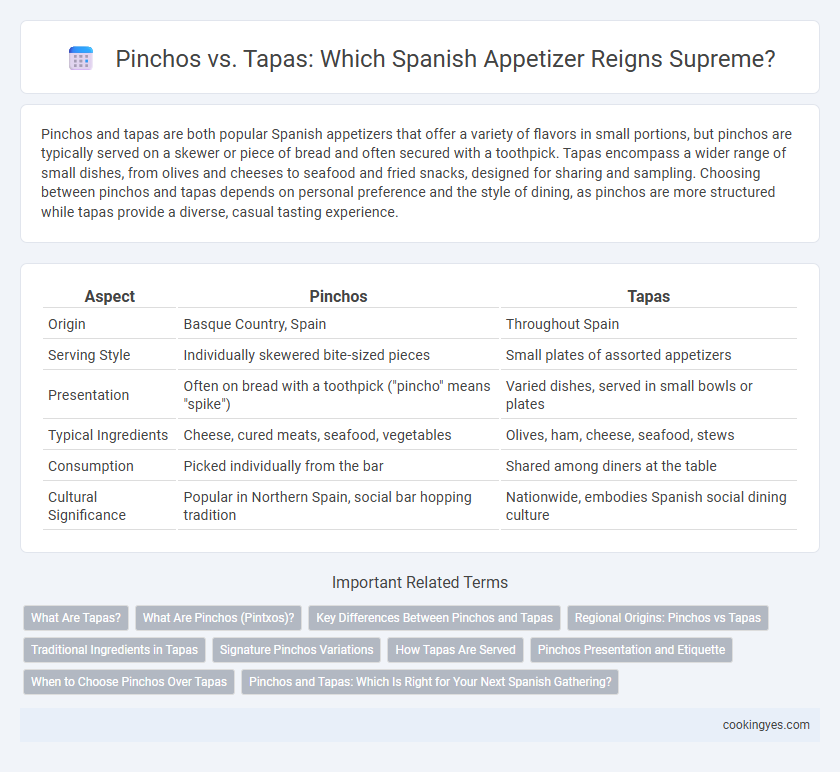Pinchos and tapas are both popular Spanish appetizers that offer a variety of flavors in small portions, but pinchos are typically served on a skewer or piece of bread and often secured with a toothpick. Tapas encompass a wider range of small dishes, from olives and cheeses to seafood and fried snacks, designed for sharing and sampling. Choosing between pinchos and tapas depends on personal preference and the style of dining, as pinchos are more structured while tapas provide a diverse, casual tasting experience.
Table of Comparison
| Aspect | Pinchos | Tapas |
|---|---|---|
| Origin | Basque Country, Spain | Throughout Spain |
| Serving Style | Individually skewered bite-sized pieces | Small plates of assorted appetizers |
| Presentation | Often on bread with a toothpick ("pincho" means "spike") | Varied dishes, served in small bowls or plates |
| Typical Ingredients | Cheese, cured meats, seafood, vegetables | Olives, ham, cheese, seafood, stews |
| Consumption | Picked individually from the bar | Shared among diners at the table |
| Cultural Significance | Popular in Northern Spain, social bar hopping tradition | Nationwide, embodies Spanish social dining culture |
What Are Tapas?
Tapas are small Spanish appetizers traditionally served with drinks, designed to encourage sharing and socializing. Unlike pinchos, which are typically skewered snacks often found in northern Spain, tapas encompass a wider variety of bite-sized dishes such as olives, chorizo, and tortilla espanola. These flavorful portions showcase regional ingredients and culinary traditions throughout Spain, making tapas an integral part of Spanish dining culture.
What Are Pinchos (Pintxos)?
Pinchos, also known as pintxos, are traditional Spanish appetizers originating from the Basque Country, characterized by small slices of bread topped with a variety of ingredients held together by a skewer or toothpick. Unlike tapas, which vary widely and can be served as small plates, pinchos are typically bite-sized and often enjoyed as a social snack with drinks. The key semantic entities include pintxos, Basque Country, skewer, and small bread slices with diverse toppings.
Key Differences Between Pinchos and Tapas
Pinchos are typically small skewered appetizers originating from Northern Spain, often featuring individual portions served on a slice of bread and secured with a toothpick, whereas tapas are broader Spanish appetizers that can range from simple olives to elaborate dishes served in larger portions. Pinchos emphasize individual servings and presentation, usually requiring payment per piece counted by the toothpick, while tapas are commonly shared dishes ordered by the plate and enjoyed communally. The key differences lie in regional origins, serving style, and portion size, with pinchos focusing on bite-sized, portable snacks and tapas encompassing a wider variety of traditional Spanish foods.
Regional Origins: Pinchos vs Tapas
Pinchos, originating mainly from the Basque Country and northern Spain, are small snacks typically served on a skewer or toothpick, often featuring a piece of bread as a base topped with various ingredients. Tapas, prevalent throughout southern Spain, especially Andalusia, encompass a broader category of appetizers that can be cold or hot dishes served in small portions, not necessarily attached to bread. The regional origins highlight distinct culinary traditions: pinchos emphasize portable, bite-sized creations with a focus on seafood and local produce, while tapas provide a diverse array reflecting the rich flavors of southern Spanish cuisine.
Traditional Ingredients in Tapas
Traditional Spanish tapas feature a variety of ingredients such as olives, chorizo, manchego cheese, and marinated seafood, emphasizing bold Mediterranean flavors. Unlike pinchos, which often rely on skewered components and bread bases, tapas are served in small portions that showcase regional produce and artisanal preparations. Classic tapas highlight fresh vegetables, cured meats, and flavorful spices like smoked paprika, preserving authentic Spanish culinary heritage.
Signature Pinchos Variations
Signature Pinchos variations highlight intricate combinations of ingredients skewered on bread, often featuring marinated seafood, cured meats, and vibrant vegetables that emphasize regional Spanish flavors. Unlike traditional tapas, pinchos offer a concentrated bite with artistic presentation, such as Gambas al Ajillo pinchos or Chorizo with roasted peppers, making them a standout appetizer option. This method of serving enhances both texture and taste, aligning with Spain's culinary tradition of small, flavorful shared dishes.
How Tapas Are Served
Tapas are typically served as small, shared dishes presented on individual plates or bowls, encouraging communal dining and casual snacking. Unlike pinchos, which are often skewered and served individually on bread slices, tapas offer a diverse range of flavors and textures without the need for toothpicks or skewers. This serving style allows diners to sample multiple dishes simultaneously, reflecting the social and informal nature of Spanish appetizers.
Pinchos Presentation and Etiquette
Pinchos, distinctively skewered and artistically presented on small slices of bread, emphasize visual appeal and individual portions in Spanish appetizers. Etiquette dictates that diners use toothpicks, which double as a means for counting consumption and settling the bill. This careful presentation and customary practice distinguish pinchos from traditional tapas, enhancing the social and culinary experience.
When to Choose Pinchos Over Tapas
Pinchos, distinguished by their skewered presentation and individual servings, are ideal when seeking a quick, visually appealing appetizer that pairs well with drinks in lively social settings. Opt for pinchos during casual gatherings or bars where variety and ease of consumption without utensils matter most. Tapas, being more varied in size and shared style, fit better for sit-down meals emphasizing communal dining over rapid snacking.
Pinchos and Tapas: Which Is Right for Your Next Spanish Gathering?
Pinchos and tapas both offer authentic Spanish appetizer experiences, with pinchos typically served on a skewer or toothpick and often featuring more elaborate toppings, while tapas are small plates designed for sharing a variety of flavors. Pinchos are popular in northern Spain, especially in Basque Country, making them ideal for interactive gatherings where guests sample diverse bites. Choosing between pinchos and tapas depends on whether you prefer a visually striking, bite-sized focus or a broader selection of traditional dishes for a communal dining atmosphere.
Pinchos vs Tapas for Spanish appetizers Infographic

 cookingyes.com
cookingyes.com